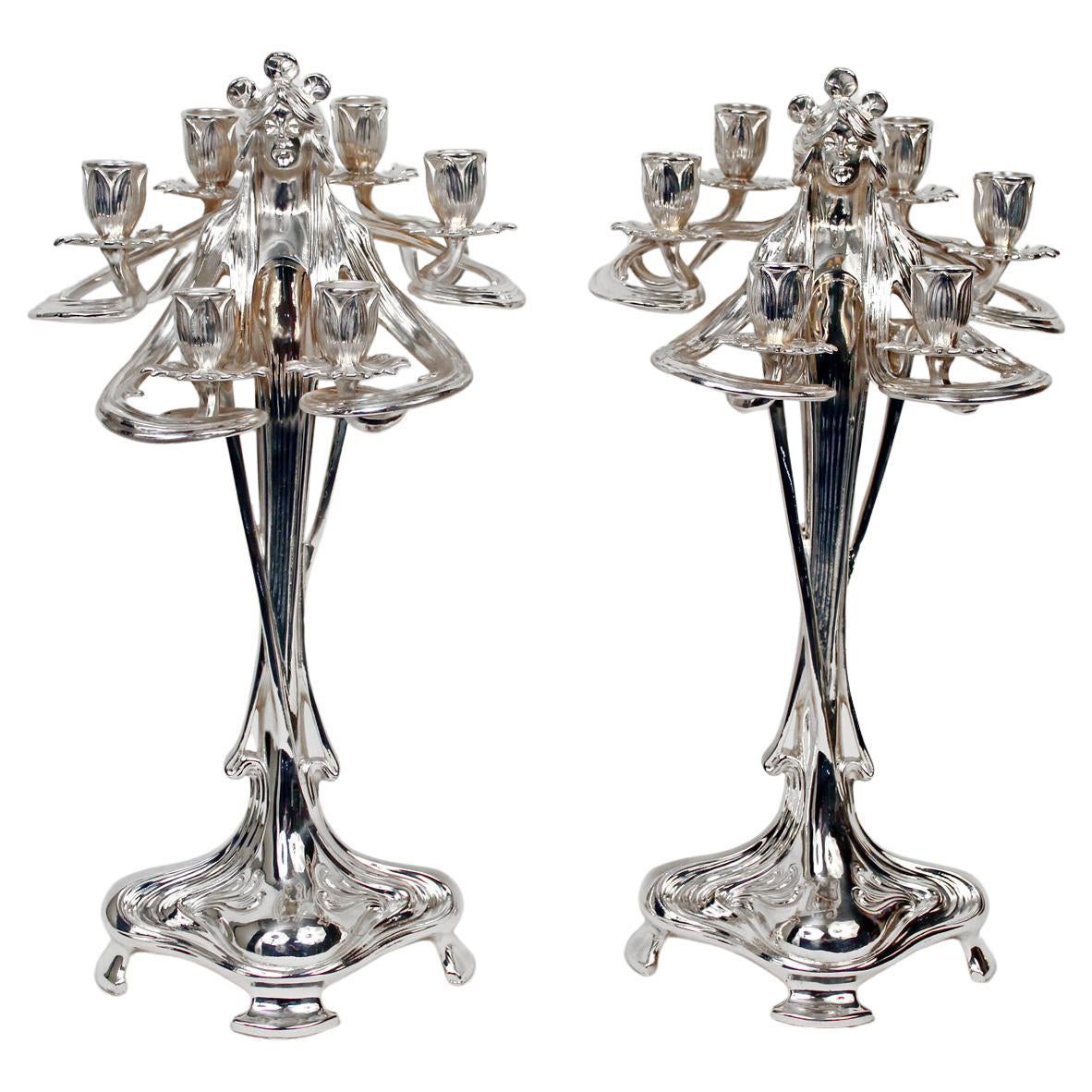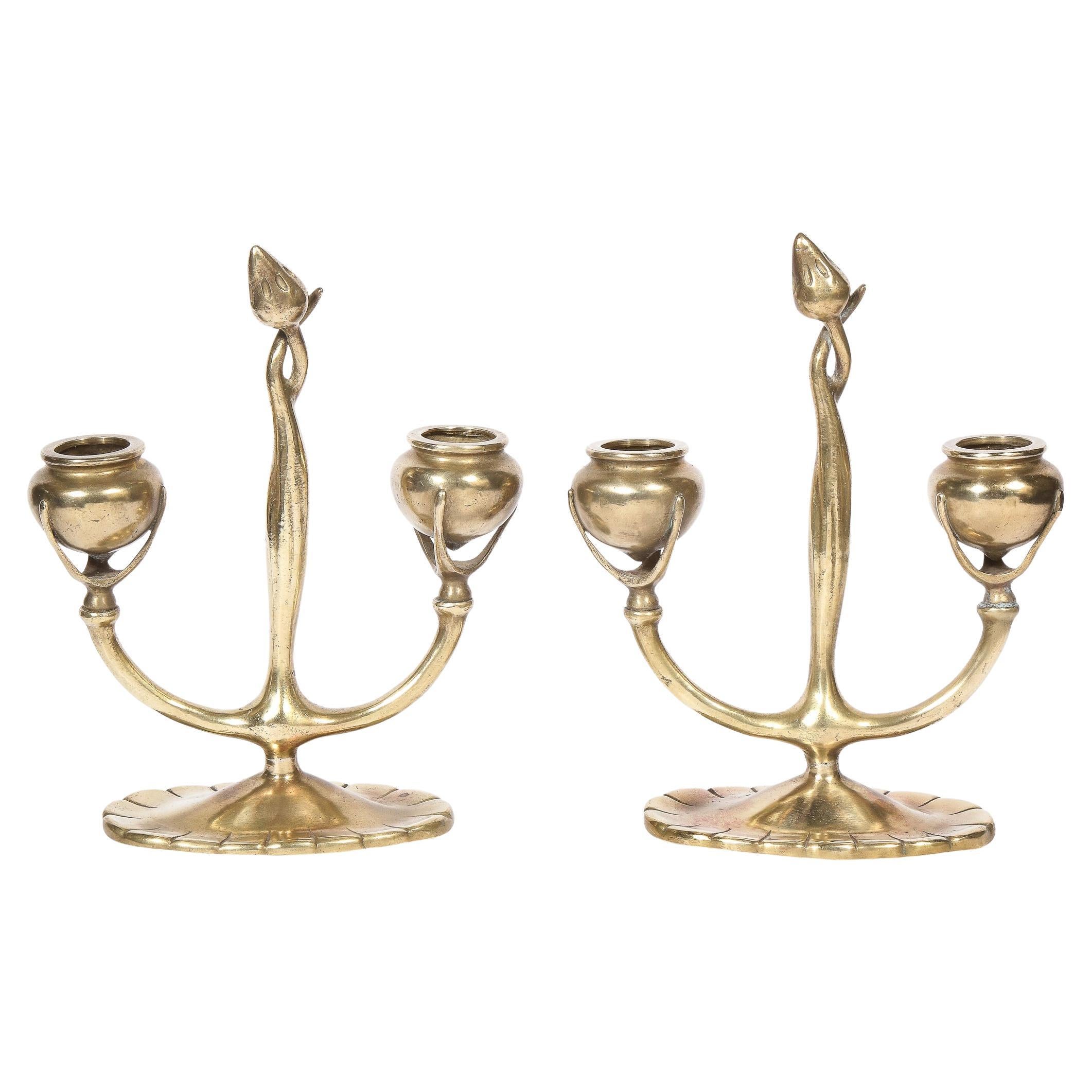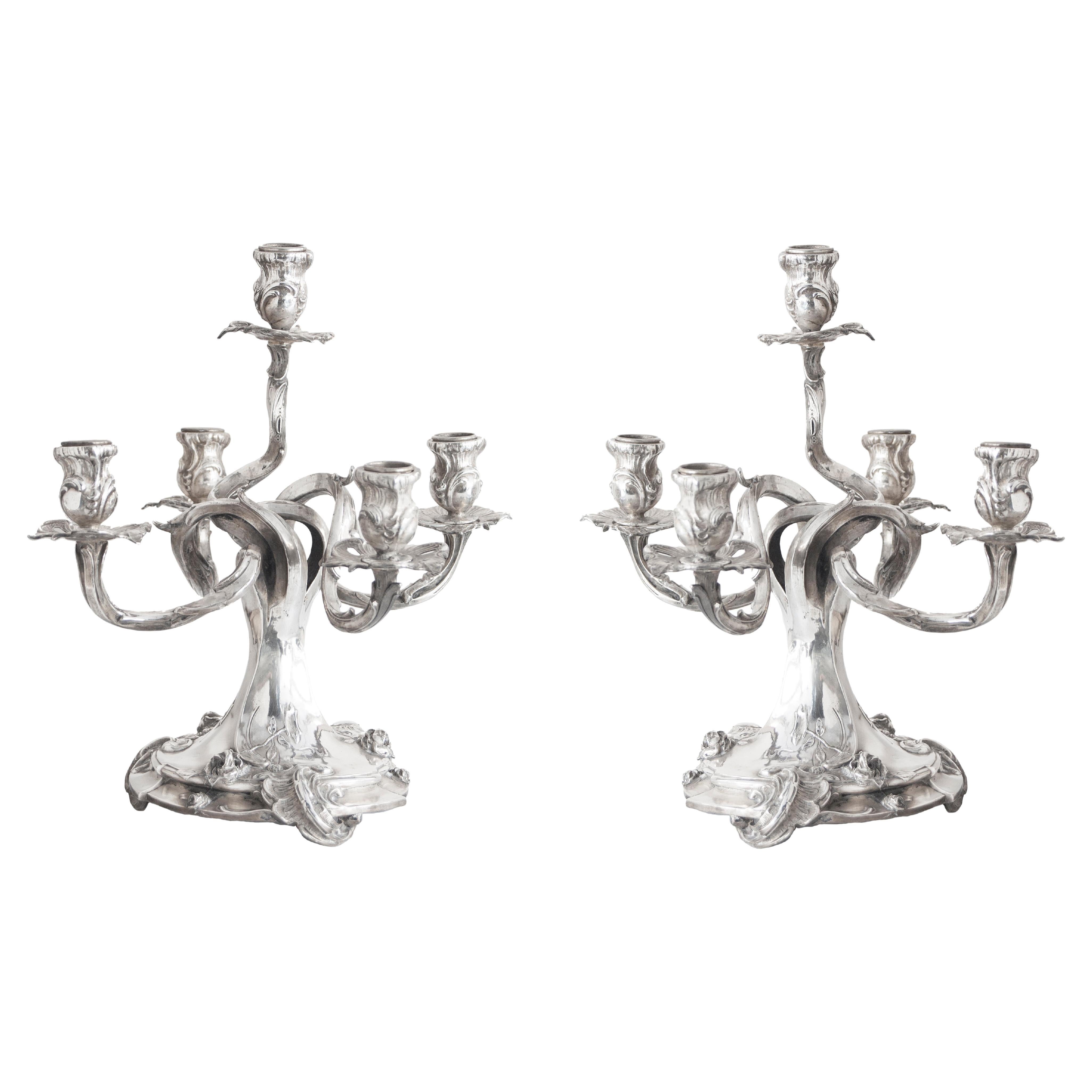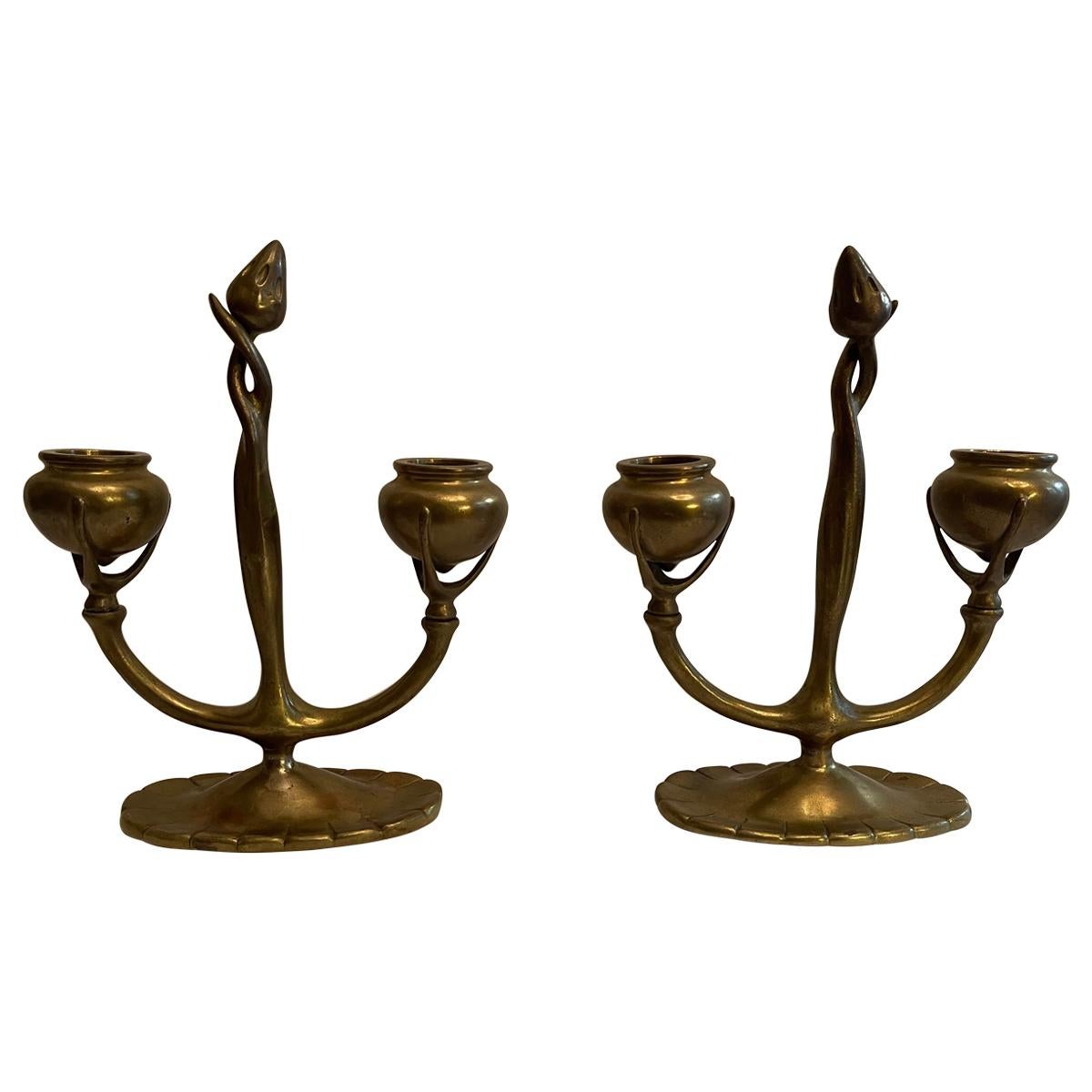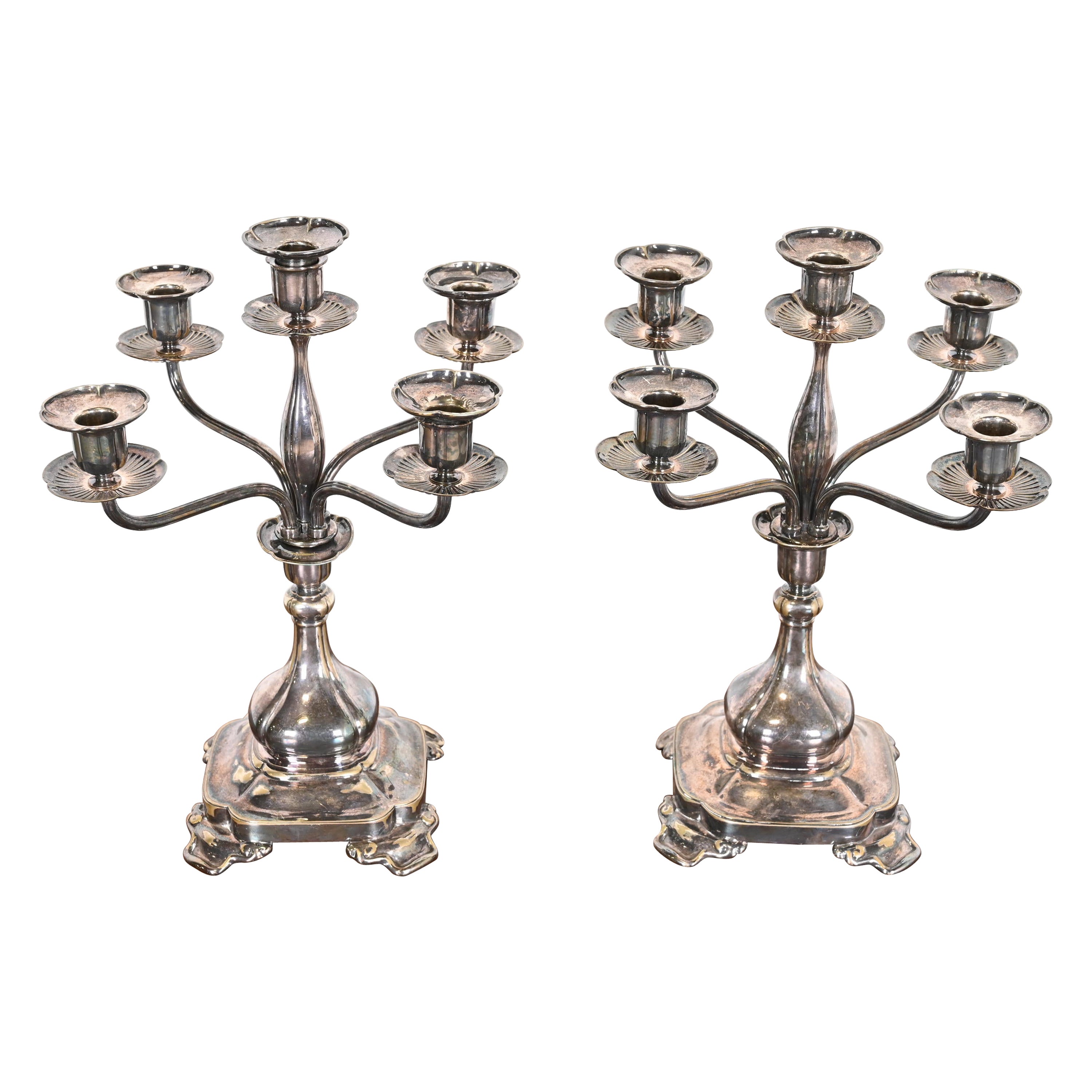Tiffany & Co. 1902 New York Art Nouveau Pair of Convertible Candelabras Sterling
About the Item
- Creator:Tiffany & Co. (Maker),Charles L. Tiffany (Designer)
- Dimensions:Height: 13.6 in (34.55 cm)Width: 12.5 in (31.75 cm)Depth: 5.3 in (13.47 cm)
- Sold As:Set of 2
- Style:Art Nouveau (Of the Period)
- Materials and Techniques:
- Place of Origin:
- Period:1900-1909
- Date of Manufacture:1902
- Condition:Wear consistent with age and use. The overall condition of this piece excellent. Beside the little normal wear, there is no damage to the sterling surfaces. This piece has been carefully inspected to guarantee the condition and authenticity.
- Seller Location:Miami, FL
- Reference Number:
Tiffany & Co.
Tiffany & Co. is one of the most prominent purveyors of luxury goods in the United States, and has long been an important arbiter of style in the design of diamond engagement rings. A young Franklin Delano Roosevelt proposed to his future wife, Eleanor, with a Tiffany ring in 1904. Vanderbilts, Whitneys, Astors and members of the Russian imperial family all wore Tiffany & Co. jewels. And Jacqueline Kennedy Onassis preferred Tiffany china for state dinners at the White House.
Although synonymous with luxury today, the firm started out rather modestly. Charles Lewis Tiffany and John B. Young founded it in Connecticut as a “stationery and fancy goods emporium” in 1837, at a time when European imports still dominated the nascent American luxury market. In 1853, Charles Tiffany — who in 1845 had launched the company’s famed catalog, the Blue Book, and with it, the firm’s signature robin’s-egg blue, which he chose for the cover — shifted the focus to fine jewelry. In 1868, Tiffany & Co. gained international recognition when it became the first U.S. firm to win an award for excellence in silverware at the Exposition Universelle in Paris. From then on, it belonged to the pantheon of American luxury brands.
At the start of the Gilded Age, in 1870, Tiffany & Co. opened its flagship store, described as a "palace of jewels" by the New York Times, at 15 Union Square West in Manhattan. Throughout this period, its designs for silver tableware, ceremonial silver, flatware and jewelry were highly sought-after indicators of status and taste. They also won the firm numerous accolades, including the grand prize for silverware at the Paris Exposition of 1878. Among the firm’s glittering creations from this time are masterworks of Art Nouveau jewelry, such as this delicate aquamarine necklace and this lavish plique-à-jour peridot and gold necklace, both circa 1900.
When Charles Lewis Tiffany died, in 1902, his son Louis Comfort Tiffany became the firm’s design director. Under his leadership, the Tiffany silver studio was a de facto design school for apprentice silversmiths, who worked alongside head artisan Edward C. Moore. The firm produced distinctive objects inspired by Japanese art and design, North American plants and flowers, and Native American patterns and crafts, adding aesthetic diversity to Tiffany & Co.’s distinguished repertoire.
Tiffany is also closely associated with diamonds, even lending its name to one particularly rare and exceptional yellow stone. The firm bought the Tiffany diamond in its raw state from the Kimberley mines of South Africa in 1878. Cut to create a 128.54-carat gem with an unprecedented 82 facets, it is one of the most spectacular examples of a yellow diamond in the world. In a broader sense, Tiffany & Co. helped put diamonds on the map in 1886 by introducing the American marketplace to the solitaire diamond design, which is still among the most popular engagement-ring styles. The trademark Tiffany® Setting raises the stone above the band on six prongs, allowing its facets to catch the light. A lovely recent example is this circa-2000 platinum engagement ring. Displaying a different design and aesthetic (but equally chic) is this exquisite diamond and ruby ring from the 1930s.
- ShippingRetrieving quote...Ships From: Miami, FL
- Return PolicyA return for this item may be initiated within 1 day of delivery.
- Tiffany & Co. 1900 Charles L Tiffany Edwardian Art Nouveau Sterling Trumpet VaseBy Tiffany & Co., Charles L. TiffanyLocated in Miami, FLTrumped vase designed by Tiffany & Co. Beautiful antique trumpet vase made at the Tiffany studios in New York city, between the 1900 and 1901. ...Category
Antique Early 1900s American Edwardian Vases
MaterialsSilver, Sterling Silver
- Charles Harleux 1895 Paris Art Nouveau Pair of Candlestick in Sterling SilverBy Charles HarleuxLocated in Miami, FLArt nouveau candlesticks designed by Charles Harleux. Very rare late 19th century pair of table candlestick, created in Paris France by the master silversmith Charles Harleuz, bac...Category
Antique Late 19th Century French Art Nouveau Candlesticks
MaterialsSilver, Sterling Silver
- Tiffany & Co. 1858 New York Round Display Tray In Solid .925 Sterling SilverBy Tiffany & Co., John C. MooreLocated in Miami, FLA display round tray designed by Tiffany & Co. Beautiful antique three footed round display tray, created in New York city for Tiffany & Co. between the 1858-1859. This tray certainly is one of the first pieces made at the 550 Broadway avenue in solid .925/1000 sterling silver. It was made up with American classic patterns and mount in three elaborated legs. As with all Tiffany pieces, the quality and design are beyond compare. Exceptional and rare example of Tiffany's finest work. Weight: 175.85 Grams (112.72 Dwt). Measurements: Diameter of 146.05 mm and a height of 24.2 mm (5.75 x 0.95 inches). Hallmarks: Stamped twice with the maker's mark, the gothic letter "M" associated to J.C. Moore & Sons (1854-1869), the model number 867, the order numbers 9008 and signed in full. "TIFFANY & CO. M 867 ENGLISH STERLING 925/1000 M 9008 550 BROADWAY". In addition is engraved with the inventory numbers 441. Note: Tiffany silver hollowware and flatware is generally marked Tiffany & Co and generally includes date letters indicating the period it was made. Flatware also usually includes a pattern number. The first date...Category
Antique 1850s American American Classical Sterling Silver
MaterialsSilver, Sterling Silver
- Cleto Munari 1985 Milano Pair of Modernist Geometric Candlesticks .925 SterlingBy Cleto MunariLocated in Miami, FLA pair of geometric candlesticks. designed by Cleto Munari (1907-1998). Great sculptural pieces created in very limited edition by the Italian architect Cleto Munari. they are hand crafted in solid .925/1000 sterling silver. In 1985 Cleto Munari, set up a workshop-studio for the manufacture of unique objects in collaboration with some of the greatest architects, designers, artists, and writers in the world, among them Mario Botta, Alessandro Mendini, Alvaro Siza Vieira...Category
Late 20th Century Italian Post-Modern Sterling Silver
MaterialsSilver, Sterling Silver
- Tiffany & Co. 1920 Art Deco 8 Days Desk Clock Sterling Silver & Enamel with BoxBy Concord, Tiffany & Co.Located in Miami, FLA desk clock designed by Tiffany & Co. A beautiful and elegant easel back desk clock, created in New York city by the Tiffany & Co. studios, during the art deco period back in the early 1920. This rare piece has been designed in a squared curvilinear shape and carefully crafted up in solid sterling silver .935/.999 . The watch is gilded and is fully embellished with applications of purple-violet and white enamels over a geometric guilloche patterns. It is fitted at the reverse, with an easel back retractable hinged stand. Movement: Is Swiss mechanical wingding, 8 days. The dial is creme-white with arabic golden numerals and with black hands and inscribed, Tiffany & Co. Swiss. Weight: 180.95 Grams, (1115.99 Dwt). Measurements: 80 mm by 80 mm by 16.5 mm (3.15 x 3.15 x 0.65 Inches). Clocks Hallmarks: Stamped with the maker's mark and signed, "TIFFANY & CO. 8 DAYS SWISS". Case Hallmarks: Stamped with the maker's mark monogram, the Swiss mark of the standing Bear for the silver assay, and signed, "CONCORD WATCH CO. STERLING SILVER ARGENT 0.935 CONCORD W. CO SWISS 1608". Concord Watch Co, was founded in Biel, Switzerland in 1908. From the start, the company had its sights set on the American market. Concord produced luxury watches for several jewelry companies, including Tiffany & Co. and Cartier. During peace talks in the Second World War, President Harry Truman gave Concord watches as a gifts to Joseph Stalin and Winston Churchill. The North American Watch Company...Category
Vintage 1920s North American Art Deco Table Clocks and Desk Clocks
MaterialsSterling Silver, Enamel
- French 1870 Pair of Empire Candle Holders Lamps Ormolu with Gray Dotted GraniteLocated in Miami, FLFrench empire pair of candle holders lamps. Exceptional pair of antique candleholders, created in Paris France during the imperial period of Napoleon III, circa 1870. They was designed with French empire neoclassical patterns, masterfully crafted with parts made up in gilt bronze ormolu and patinated bronze. Mounted in fluted columns pedestals carved from gray dotted Granite, with polished finish. Embellished with garlands and putties mounted in a four square and stepped bases. Weight: Combined of 12 Pounds (5.45 Kilos). Measurements: 15 Height by 4.50 Length by 5.15 Width Inches, (38 x 11.43 x 13.08 Cm). French Empire Louis Napoleon Bonaparte (1808-1873) was Emperor of France from 1852 to 1870 under the name of Napoleon III. In a way, the artistic codes of the Napoleon III style, also called Second Empire style, were presented at the Exhibition of 1844, during the reign of Louis-Philippe d'Orléans. The second Empire style, also known as the Napoleon III style, is a highly eclectic style of architecture and decorative arts, which uses elements of many different historical styles, and also made innovative use of modern materials, such as iron frameworks and glass skylights. It flourished during the reign of Emperor Napoleon III in France (1852–1870) and had an important influence on architecture and decoration in the rest of Europe and North America. Major examples of the style include the Opéra Garnier (1862–1871) in Paris by Charles Garnier, the Bibliothèque nationale de France, the Church of Saint Augustine (1860–1871), and the Philadelphia City Hall (1871–1901). The architectural style was closely connected with Haussmann's renovation of Paris carried out during the Second Empire; the new buildings, such as the Opéra, were intended as the focal points of the new boulevards. Comfort was the first priority of Second Empire furniture...Category
Antique 1870s French Empire Table Lamps
MaterialsGranite, Bronze, Ormolu
- Pair of Tiffany & Co. Sterling Silver 5-Light Monumental Repousse CandelabraBy Tiffany & Co.Located in New York, NYPair of Tiffany & Co. sterling silver 5-light monumental candelabra in the tasteful, hand-chased repousse motif, finely executed with a spread of 5 arms. From circa 1907 and in crisp...Category
Antique Early 1900s American Candelabras
MaterialsSilver, Sterling Silver
- Pair of Medusa Art Nouveau CandelabrasBy WMF Württembergische MetallwarenfabrikLocated in Miami, FLPair of iconic Art Nouveau silver plated candle holders by WMF depicting two female figures. Made in Germany. Circa: 1900.Category
Early 20th Century French Art Nouveau Candelabras
MaterialsMetal, Silver Plate
- Pair of Art Nouveau Bronze Sculptural Floral Candelabras Signed Tiffany StudiosBy Tiffany StudiosLocated in New York, NYThis stunning pair of bronze Art Nouveau candelabras were realized in the United States circa 1910 by Tiffany Studios- one of America's finest luxury goods companies since 1837. They feature graphic and sculptural forms consisting of two urn...Category
Vintage 1910s American Art Nouveau Candelabras
MaterialsBronze
- Pair of Candelabras, Jugendstil, Art Nouveau, FranceLocated in Ciudad Autónoma Buenos Aires, CCenterplace Metal: Silver plated We have specialized in the sale of Art Deco and Art Nouveau and Vintage styles since 1982.If you have any questions we are at your disposal. Pus...Category
Antique Early 1900s French Art Nouveau Candelabras
MaterialsMetal
- Wonderful Pair of Tiffany Studios Dore Bronze Art Nouveau Two Arm CandelabrasBy Tiffany StudiosLocated in Roslyn, NYA wonderful pair of Tiffany Studios Poppy flower bud centers candelabrum, in the Art Nouveau Design finished in doré bronze gold finish Stamped: Ti...Category
20th Century American Art Nouveau Candelabras
MaterialsBronze
- Tiffany & Co. Antique Silver Five-Arm Candelabra, PairBy Tiffany & Co.Located in South Bend, INA gorgeous pair of antique silver plate five-light candelabra By Tiffany & Co. (signed at the base) USA, Circa Late 19th Century Each measures: 14"W x 14"D x 15.5"H. Good origina...Category
Antique Late 19th Century American Regency Candelabras
MaterialsSilver Plate
Recently Viewed
View AllRead More
The Sparkling Legacy of Tiffany & Co. Explained, One Jewel at a Time
A gorgeous new book celebrates — and memorializes — the iconic jeweler’s rich heritage.
15 Scintillating Jewelry Watches to Elevate Your Holiday Style
Watchmakers have tucked their movements into all manner of precious baubles, from lapel pins to cocktail rings. The result is dazzling, wearable art that will get you to the party on time.

